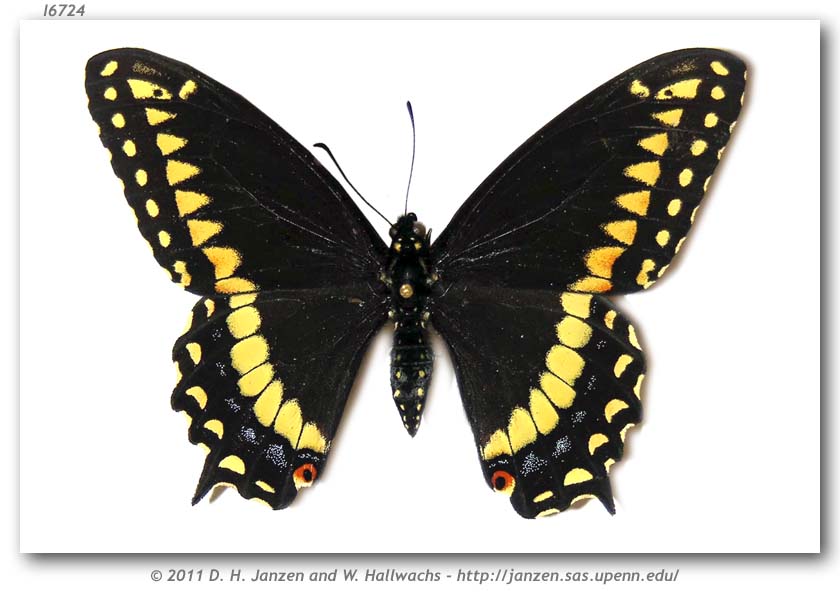Swallowtails Flourish at Silo Center
One of my favorite things about insects, butterflies in particular, is their tendency to rely on a specific type of plant for part or all of their lives. When one species has evolved a dependency on another for survival it is referred to as a “host-species” relationship. If an animal requires a certain plant to live and that plant isn’t around to “host” them, you can bet the animal won’t be found either! Knowing the host-plants for an insect and how to find those plants is a huge leg up in the quest to find and observe cool insects.
There is a great opportunity to do this right now in The Parklands. The black swallowtail butterfly (Papilio polyxenes) is a large, showy butterfly that is probably recognizable to most people that live in the eastern United States. As an adult the black swallowtail feeds on the nectar of a variety of flower species. During their larval stage as caterpillars however, they have a host-specific relationship with plants in the family Apiacieae, more commonly known as the carrot family.
Out of the carrot family one of the very best host plants is golden alexander (Zizia aurea). A tough native wildflower typically growing around 3 feet tall, golden alexander is commonly found in meadows or woodland openings where it’s flat-topped stalks of small yellow flowers light up the early spring. The flowers are long gone by now but the plant can still be identified by the leaves, which are compound biternate (each leaf has three leaflets which each contain three more leaflets) and toothed. If that description doesn’t help, just look for a stout, thick-leaved parsley look-alike! In The Parklands you can find golden alexander in landscape beds across the road from the Limestone Gorge in Broad Run Park and in various beds around the Brown-Forman Silo Center in Turkey Run Park.
Black swallowtail caterpillars feed off of golden alexander at Brown-Forman Silo Center.
It was at the Silo Center that the gardening team found some black swallowtail caterpillars Tuesday afternoon. They are most likely a member of the final 2016 mating generation. After several generations throughout the summer in which the adults live several weeks, the last group of caterpillars (which I am guessing will be these guys’ kids) remain as a chrysalis throughout the winter and emerge the following spring. The caterpillars we saw appear to be in their final larval instar, indicating they will soon enter the chrysalis stage.
I love seeing cool and unexpected insects, but I loved finding these little caterpillars for another reason as well. It’s been a hot summer, and for a while it’s also been pretty dry. I’ll be honest, a lot of our golden alexanders aren’t looking so great right now. In fact, there are plants all over the park that look pretty tired and worn out from the past month. That’s partly why the gardening team was looking at the golden alexanders at the Silo Center. We were commenting on how they seemed a bit haggard.
Then I heard someone say “Hey! What’s that?” I looked over and, sure enough, there was a colorful yellow and black head poking out from behind a leaf, munching away. I looked a little closer and I saw another one. I took a second look at the plant I’d just passed and saw there was a caterpillar on that one as well. The golden alexanders didn’t look so haggard to me at that point. You gain a new perspective when you realize a plant is nurturing the next generation of a gorgeous butterfly species. It’s easy to lose appreciation for all we have sometimes. I’m more than happy to be reminded by caterpillars.
You may have one lingering question at this point. Why does the black swallowtail only eat plants in the family Apiaceae? It turns out it’s a defense mechanism. The leaves of golden alexander and some other members of the Apiaceae contain toxins that the black swallowtail caterpillar is able to safely ingest and then store in their bodies. This makes the caterpillars unpalatable to birds. This is a similar strategy employed by monarch butterflies who consume the toxins in milkweed plants (You might notice that the color patterns on monarch and black swallowtail caterpillars are very similar. Can you think why this might be?). Unlike monarchs, however, black swallowtails are not protected by the toxins into adulthood. They rely on their ability as agile flyers to evade predators.
If you happen to go looking for the swallowtails we ask that you are gentle with the plants and gentle with the caterpillars. The best way to observe them is to get down next to the plant. When a caterpillar is under a leaf or in a hard to see place, I gently brush other leaves aside until I have a good view. It feels good when I know I’ve left something just as healthy as I found it. If you’re feeling especially ambitious, you might try searching for a chrysalis as well. Look for them to be attached to vertical surfaces such as trees, fences, or walls. I can confirm there is one somewhere at the Silo Center. You’ll know it’s a swallowtail chrysalis because it has horns and a little silk harness.

Black swallowtail chrysails
Lastly, if you’re going to go, go soon! They won’t be caterpillars for long! Happy swallowtail searching!
More detailed information on black swallowtails and their life history.

 Chris Erickson
Chris Erickson
As a Parklands Zone Gardener, Chris Erickson supports the planning and maintenance of gardens throughout Turkey Run and Broad Run Parks. Chris joined The Parklands team in the spring of 2016 after spending time as a teacher in the northeast.


